Stave church


A stave church is a medieval wooden Christian church building once common in north-western Europe. The name derives from the buildings' structure of post and lintel construction, a type of timber framing where the load-bearing ore-pine posts are called stafr in Old Norse (stav in modern Norwegian). Two related church building types also named for their structural elements, the post church and palisade church, are often also called 'stave churches'.
Originally much more widespread, most of the surviving stave churches are in Norway. The only remaining medieval stave churches outside Norway are those of circa 1500 at Hedared in Sweden and one Norwegian stave church relocated in 1842 to the outskirts of Krummhübel, Germany, now Karpacz in the Karkonosze mountains of Poland. (One other church, the Anglo-Saxon Greensted Church in England, exhibits many similarities with a stave church but is generally considered a palisade church.)
Construction
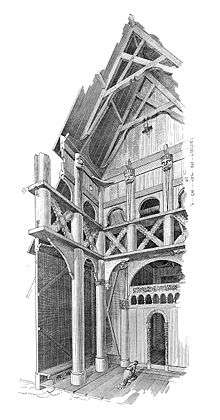
Archaeological excavations have shown that stave churches, best represented today by the Borgund stave church, are descended from palisade constructions and from later churches with earth-bound posts.
Similar palisade constructions are known from buildings from the Viking Age. Logs were split in two halves, set or rammed into the earth (generally called post in ground construction) and given a roof. This proved a simple but very strong form of construction. If set in gravel, the wall could last many decades, even centuries. An archaeological excavation in Lund uncovered the postholes of several such churches.
In post churches, the walls were supported by sills, leaving only the posts earth-bound. Such churches are easy to spot at archaeological sites as they leave very distinct holes where the posts were once placed. Occasionally some of the wood remains, making it possible to date the church more accurately using radiocarbon dating and/or with dendrochronology. Under the Urnes stave church, remains have been found of two such churches, with Christian graves discovered beneath the oldest church structure.
A single church of palisade construction has been discovered under the Hemse stave church.
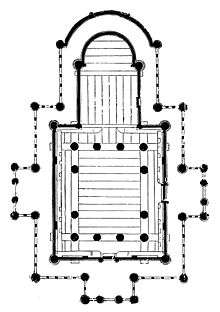
The next design phase resulted from the observation that earthbound posts were susceptible to humidity, causing them to rot away over time. To prevent this, the posts were placed on top of large stones, significantly increasing their lifespans. The stave church in Røldal is believed to be of this type.
In still later churches, the posts were set on a raised sill frame resting on stone foundations. This is the stave church in its most mature form.
It is now common to group the churches into two categories: the first, without free-standing posts, often referred to as Type A; and the second, with a raised roof and free-standing internal posts, usually called Type B.
Those with the raised roof, Type B, are often further divided into two subgroups. The first of these, the Kaupanger group, have a whole arcade row of posts and intermediate posts along the sides and details that mimic stone capitals. These churches give an impression of a basilica.
The other subgroup is the Borgund group. These churches have cross-braces joining upper and lower string beams and the posts, forming a very rigid interconnection, and resembling the triforium of stone basilicas. This design made it possible to omit the freestanding lower part of intermediate posts. In some churches in Valdres, only the four corner posts remain (see image of Lomen stave church).
Many stave churches had or still have outer galleries around their whole perimeters, loosely connected to the plank walls. These probably served to protect the church from a harsh climate, and for processions.
Single nave church, Type A
At the base of Type A churches there are four heavy sill beams on a low foundation of stones. These are interconnected in the corner notch, forming a rigid sill frame. The corner posts or staves (stavene in Norwegian) are cross-cut at the lower end and fit over the corner notches and cover them, protecting them from moisture.
On top of the sill beam is a groove into which the lower ends of the wall planks (veggtilene) fit. The last wall plank is wedge-shaped and rammed into place. When the wall is filled in with planks, the frame is completed by a wall plate (stavlægje) with a groove on the bottom, holding the top ends of the wall planks. The whole structure consists of frames—a sill frame resting on the stone foundation, and the four wall frames made up of sills, corner posts and wall plate.
The wall plates support the roof trusses, consisting of a pair of principal rafters and an additional pair of intersecting "scissor rafters". For lateral bracing, additional wooden brackets (bueknær) are inserted between the rafters.
Every piece is locked into position by other pieces, making for a very rigid construction; yet all points otherwise susceptible to the harsh weather are covered.
- The single nave church has a square nave and a narrower square choir. This type of stave church was common at the beginning of the 12th century.
- The long church, (Langkirke), has a rectangular plan with nave and choir of the same width. The nave will usually take up two thirds of the whole length. This type was common at the end of the 13th century.
- The center post church, (Midtmastkirke) has a single central post reaching all the way up to and connected to the roof construction. But the roof is a simple hipped one, without the raised central part of the Type B churches. This variation on the common type of church, found in Numedal and Hallingdal, dates to around 1200.
Single nave churches in Norway: Grip, Haltdalen, Undredal, Hedal, Reinli, Eidsborg, Rollag, Uvdal, Nore, Høyjord, Røldal and Garmo.
The only remaining similar church in Sweden, in Hedared, is of this type and shows similarities with the one from Haltdalen.
Church with a raised roof, Type B
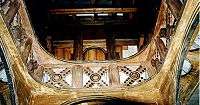
On the stone foundation four huge beams (grunnstokker) are placed like a # sign, their ends protruding 1–2 metres from the notches where they intersect. The ends of these beams support the sills of the outer walls, forming a separate horizontal frame. The tall internal posts are placed on the internal frame of large beams, and carry the main roof above the central nave (skip). On the outer frame of sills rest the main wall planks (veggtiler), carrying the roof over the pentice or aisles (omgang) surrounding the central space. The roof thus tapers down in two steps, as in a basilica.
The tall internal posts (staver) are interconnected with brackets (bueknær), and also connected to the outer walls with aisle rafters, creating a laterally rigid construction. Closer to the top of the posts (staver), shorter sills inserted between them support the upper wall (tilevegg). On top of the posts wall plates (stavlægjer) support the roof trusses, similar to those of the single nave churches.
The Kaupanger group consists of: Kaupanger, Urnes, Hopperstad and Lom.
The Borgund group consists of: Borgund, Gol, Hegge, Høre (Hurum), Lomen, Ringebu and Øye.
This form of church can also be recognized from the holes which remain from earlier earth-bound post churches built on the same sites. Little is known about what these older churches actually looked like or how they were constructed, as they were all destroyed or replaced many centuries ago.
History
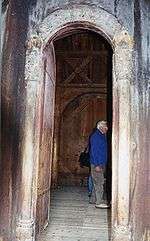
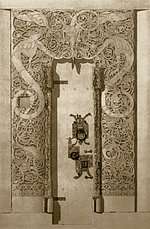
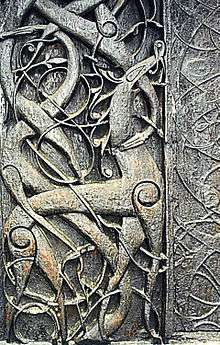
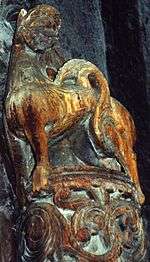
Stave churches were once common in northern Europe. In Norway alone, it was thought about 1000 were built; recent research has upped this number and it is now believed there may have been closer to 2000.[1] It is unknown how many stave churches were constructed in Iceland and in other countries in Europe.
Some believe they were the first type of church to be constructed in Scandinavia; however, the post churches are an older type, although the difference between the two is slight. A stave church has a lower construction set on a frame, whereas a post church has earth-bound posts.
In Sweden, the stave churches were considered obsolete in the Middle Ages and were replaced. In Norway, they were not replaced as quickly and many survived until the 19th century, when a substantial number were destroyed. Today, 28 historical stave churches remain standing in Norway. There are also some newer stave churches at various locations.
In Denmark, traces of post churches have been found at several locations, and there are also parts still in existence from some of them. A plank of one such church was found in Jutland. The plank is now on display at the National Museum of Denmark in Copenhagen and an attempt at reconstructing the church is a featured display at the Moesgård Museum near Aarhus. Marks created by several old post churches have also been found at the old stone church in Jelling.
In Sweden, the medieval Hedared stave church was constructed c. 1500 at the same location as a previous stave church. Other notable places are Maria Minor church in Lund, with its traces of a post church with palisades, and some old parts of Hemse stave church on Gotland. In Skåne alone there were around 300 such churches when Adam of Bremen visited Denmark in the first half of the 11th century, but how many of those were stave churches or post churches is unknown.
In England, there is one similar church of Saxon origin, with much debate as to whether it is a stave church or predates them. This is the Greensted Church in Essex. General consensus categorizes it as Saxon [A]. There is also another church which bears similarities to stave churches, the medieval stone church of St. Mary in Kilpeck in Herefordshire. It features a number of dragon heads.
In Germany, there is one stone church with a motif depicting a dragon similar to those often seen on Norwegian stave churches and on surviving artifacts from Denmark and Gotland. Whether this decoration can be attributed to cultural similarities or whether it indicates similar construction methods in Germany has sparked controversy.
There is some folklore suggesting that the stave churches were built upon old indigenous Norse worship sites. Only at one location does it seem possible to trace a connection, at Mære church in Norway. At one corner of the churchyard remnants of another building have been found, and that building could be connected to Norse paganism. In other cases there is evidence of much older churches built on the same ground; often the stones were still left in the holes created by the posts of an older post church, and under Urnes stave church there have even been discovered remains of two earlier such post churches. The old portal from one of these churches is believed to be the one built into the northern wall of the current church. Thus, newer research on the stave churches suggests that Christianity was introduced into Norway much earlier than was previously assumed.
Architecture and decoration
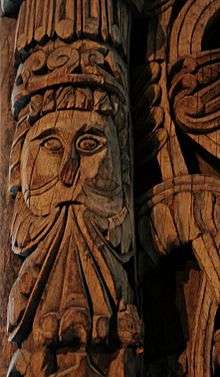
Even though the wooden churches had structural differences, they give a recognizable general impression. Formal differences may hide common features of their planning, while apparently similar buildings may turn out to have their structural elements organized completely differently. Despite this, certain basic principles must have been common to all types of building.
Basic geometrical figures, numbers that were easy to work with, one or just a few length units and simple ratios, and perhaps proportions as well were among the theoretical aids all builders inherited. The specialist was the man who knew a particular type of building so well that he could systematise its elements in a slightly different way from previous building designs, thus carrying developments a stage further.
"Exposing the timber frame on the interior and/or exterior of the structures is seen to release its matrix of timber members and its capacity to contribute architectural expression to buildings. The matrix, forming ‘lines’ in space, has an expressive potential that includes the capacity to delineate proportion, direct eye-movement, suggest spatial enclosure, create patterning, permit transparency and establish continuity with landscape."[2]
Dating of churches
Stave churches can be dated in various ways: by historical records or inscriptions, by stylistic means using construction details or ornaments, or by dendrochronology and radiocarbon dating. Often historical records or inscriptions will point to a year when the church is known to have existed. Archaeological excavations can yield finds which can provide relative dating for the structure, whereas absolute dating methods such as radiocarbon dating and dendrochronology can provide a more exact date. One drawback of dendrochronology is that it tends to overlook the possibility that the wood could have been reused from an older structure, or felled and left for many years before use.
A very important problem in dating the churches is that the solid ground sills are the construction elements most likely to have the outer parts of the log still preserved. Yet they are the most susceptible to humidity, and as people back then reused building parts, the church may have been rebuilt several times. If so, a dendrochronological dating may be based upon a log from a later reconstruction.
Old stave churches
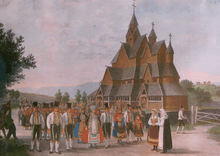
Johannes Flintoe (1828)
Norway
- A semi-official list of Norwegian stave churches which comply with specific criteria:
- Borgund stave church, Sogn og Fjordane — end of the 12th century
- Eidsborg stave church, Telemark — middle of the 13th century
- Flesberg stave church in Flesberg, Buskerud — c. 1200
- Fåvang stave church in Ringebu, Oppland — rebuilt in 1630 (two old churches rebuilt as one)
- Garmo stave church, Oppland — c. 1150
- Gol stave church in Gol (now at Norsk Folkemuseum, Oslo), Buskerud — 1212
- Grip Stave Church, Møre og Romsdal — second half of the 15th century
- Haltdalen stave church, Sør-Trøndelag — 1170–1179
- Hedal stave church, Oppland — second half of the 12th century
- Heddal stave church, Telemark — beginning of the 13th century
- Hegge stave church, Oppland — 1216
- Hopperstad stave church, Sogn og Fjordane — 1140
- Hylestad stave church, Setesdal — second half of the 12th century
- Høre stave church, Oppland — 1180
- Høyjord stave church, Andebu, Vestfold — second half of the 12th century
- Kaupanger stave church, Sogn og Fjordane — 1190
- Kvernes stave church, Møre og Romsdal — second half of the 14th century
- Lomen stave church, Oppland — 1179
- Lom stave church, Oppland — 1158
- Nore stave church, Nore og Uvdal, Buskerud — 1167
- Øye stave church, Oppland — second half of the 12th century
- Reinli stave church, Oppland — 1190
- Ringebu stave church, Oppland — first quarter of the 13th century
- Rollag stave church, Rollag, Buskerud — second half of the 12th century
- Rødven stave church, Møre og Romsdal — c. 1200
- Røldal stave church, Hordaland — first half of the 13th century (could be a post church)
- Torpo stave church, Ål, Buskerud — 1192
- Undredal stave church, Sogn og Fjordane — middle of the 12th century
- Urnes stave church, Sogn og Fjordane — first half of the 12th century (on UNESCO’s World Heritage Site)
- Uvdal Stave Church, Uvdal, Buskerud — 1168
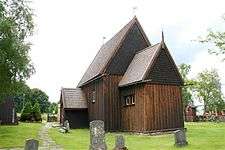
Poland
- Vang stave church, moved to Poland (no longer on the official Norwegian list due to reconstruction)
Sweden
- Hedared stave church — c. 1500 on the site of an earlier stave church (not on the official Norwegian list)
- Hemse stave church — 11th century
England
- Greensted church — 845 or 1053 (a church of Saxon origin sharing many construction details with stave churches)
Later stave churches and replicas
Stave churches are a very popular phenomenon and several have been built or rebuilt around the world. The two most copied are Borgund and Hedared, with some variations, and sometimes with adaptations to add elements from known stave churches from the area. In other places they are of a more free form, and built for display.
Denmark
- Holmens Cemetery Chapel, Holmens Cemetery, Copenhagen, Denmark, built in 1902
- Hørning Stave Church, Moesgård Museum, Aarhus, reconstruction of an old church
Sweden
- Häggviks stave church, Mannaminne museum
- Lillsjöhögen stave church (2011)
- Skaga stave church, Töreboda, Västra Götaland County, built in the 12th century, torn down in the 19th century, rebuilt in the 1950s, burnt down, and rebuilt again in 2001
Iceland
- Heimaey stave church at Heimaey, Vestmannaeyjar, built 2000
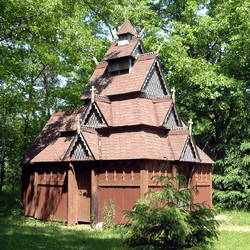
USA
- Boynton Chapel at Björklunden in Door County, Wisconsin
- Chapel in the Hills in Rapid City, South Dakota
- Hopperstad stave church (replica) at the Hjemkomst Center in Moorhead, Minnesota
- Little Norway, Wisconsin
- Scandinavian Heritage Park in Minot, North Dakota.
- St. Swithun's in Warren County, Indiana.
- Trinity Lutheran Church on Washington Island, Wisconsin
- Norway Pavilion at Epcot, Walt Disney World Resort, near Orlando, Florida
Norway
- Fantoft stave church, built c. 1150, destroyed by arson in 1992 and rebuilt in 1997 (no longer on the official list)
- Gol stave church (replica), a replica erected in the 1990s at another (improbable) site in the community from which Gol stave church was translocated in the 1880s.
- Haltdalen stave church (replica), a copy of the old church, now at Sverresborg museum
- St Olaf's Church, Balestrand, an Anglican Church, built in Dragestil, from 1897. A stave church imitation
- Vår Frue Church (Porsgrunn), a Catholic Dragestil church built in 1899 that adheres closely to stave church design
Germany
- Gustav Adolf Stave Church in Hahnenklee, Harz region, Germany
Archaeological sites and dismantled churches
Iceland
- Þórarinsstaðir archaeological excavation in Seyðisfjörður, east Iceland (Post church which predates stave church)
Norway
- Hakastein church, Skien. Archaeological excavation of post church constructed between 1010 and 1040.
- St. Thomas Church, Filefjell
- Vågå stave church (Portal from an old church)
Sweden
- Maria Minor church in Lund built around 1060
See also
- List of archaeological sites and dismantled stave churches
- Wooden Churches of Maramureș — Transylvanian churches of similar character
- Painted Churches in the Troödos Region - wooden-roofed medieval churches in Cyprus
- Kizhi - the open-air museum of Russian wooden architecture
- Medieval Scandinavian architecture
- Architecture of Norway
- Norway (Epcot)
- Chilotan architecture and Churches of Chiloé
- Heathen hof
References
Literature
- Directorate for Cultural Heritage, Stave Churches
- Anker, Peter (1997). Stavkirkene: Deres egenart og historie (in Norwegian). Oslo: J.W. Cappelens forlag. ISBN 978-82-02-15978-8.
- Lindgren, Mereth; Lydberg, Louise; Sandstrøm, Birgitta; Waklberg, Anna Greta (2002). Svensk Konsthistoria (in Swedish). Kristianstad. ISBN 978-91-85330-72-0.
- Bugge, Gunnar; Mezzanotte, Bernardino (1993). Stavkirker (in Norwegian). Oslo: Grøndahl og Dreyer. ISBN 978-82-504-2072-4.
- Bugge, Gunnar (1981). Stavkirkene i Norge (in Norwegian). Oslo: Dreyer. ISBN 978-82-09-01890-3.
- Hoftun, Oddgeir (2002). Stavkirkene - og det norske middelaldersamfunnet (in Norwegian). Copenhagen. ISBN 978-87-21-01977-8.
- Hoftun, Oddgeir (2003). Stabkirchen - und die mittelalterliche Gesellschaft Norwegens (in German). Köln: Verlag der Buchhandlung König. ISBN 978-3-88375-675-2.
- Hoftun, Oddgeir (2008). Kristningsprosessens og herskermaktens ikonografi i nordisk middelalder (in Norwegian). Oslo: Solum. ISBN 978-82-560-1619-8.
- Hohler, Erla Bergendahl (1999). Norwegian Stave Church Sculpture. 1–2. Oslo: Scandinavian University Press. ISBN 978-82-00-12748-2.
- Lagerlöf, Erland; Svahnström, Gunnar (1991). Gotlands Kyrkor (in Swedish). Kristianstad: R&S. ISBN 978-91-29-61598-2.
- Elstad, Hallgeir (2002). "Dei norske stavkyrkjene - ei innføring". Faculty of Theology, University of Oslo, curriculum.
- Hauglid, Roar, Norske Stavkirker, Oslo 1973, multipart work
- Note that Roar Hauglid is a prolific author and the listed title is just one of several. Other books by him include: Norwegische Stabkirchen, Oslo 1970, ISBN 82-09-00938-9 and Norwegian stave churches, Oslo 1970
Footnotes
- ↑ "Verdifulle stavkirker : Riksantikvaren". Riksantikvaren.no. Retrieved 2010-04-30.
- ↑ The Expressive Capacity of the Timber Frame by Brit Andresen. School of Geography, Planning and Architecture, Faculty of Engineering, Physical Sciences and Architecture, University of Queensland, QLD 4072, Australia. http://epress.lib.uts.edu.au/ocs/index.php/AASA/2007/paper/viewFile/54/7 accessed 2/11/2013
External links
| Look up Stave churches in Wiktionary, the free dictionary. |
| Wikimedia Commons has media related to Stave churches. |
- Stave Church - Medieval Wooden Churches in Norway
- Dendrochronology
- Stavkyrkor from Historiska Världer — in Swedish
- stave churches owned by the Society for the Preservation of Ancient Norwegian Monuments
- Google map of Norwegian stave churches
- List over stave churches in Norway